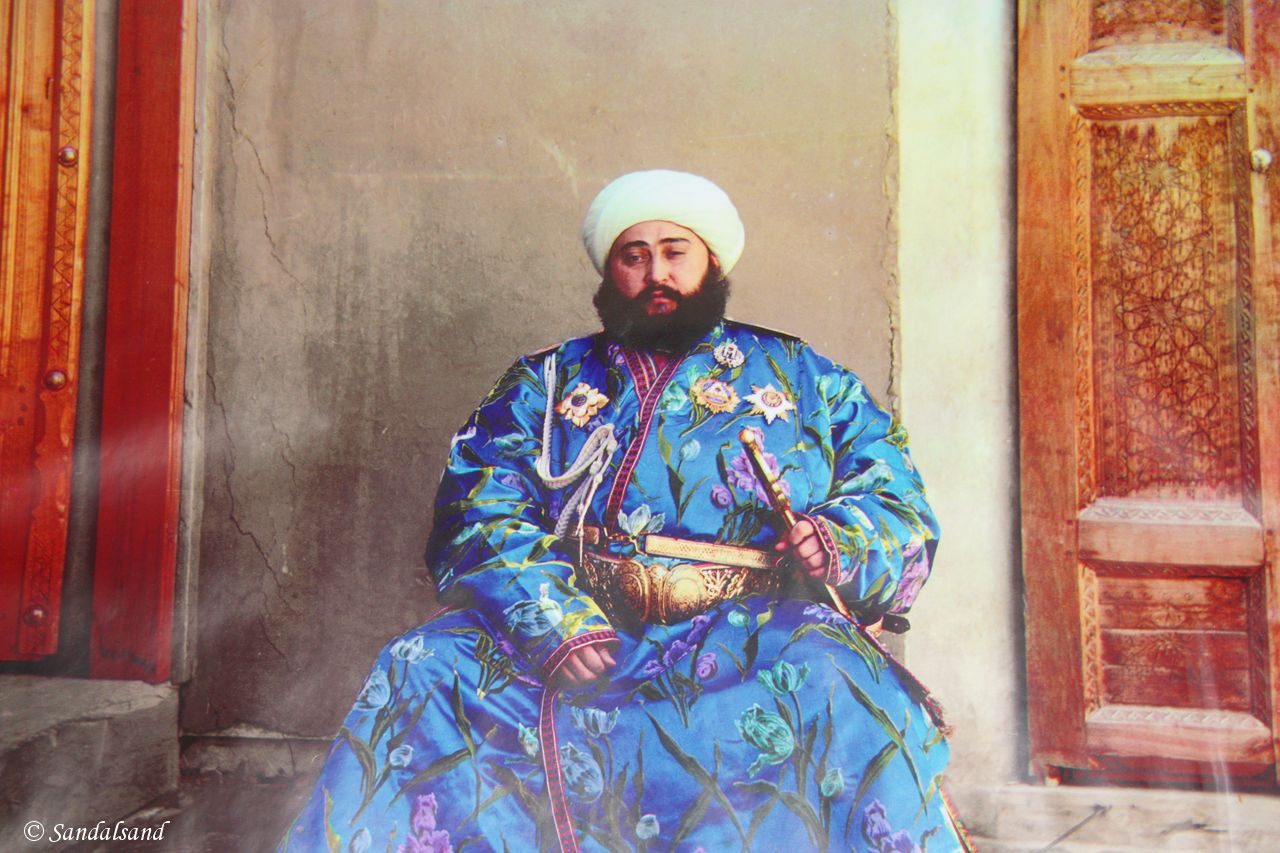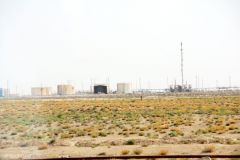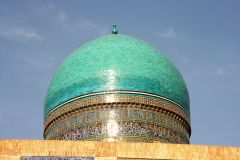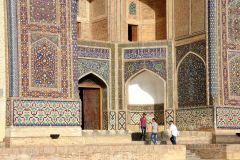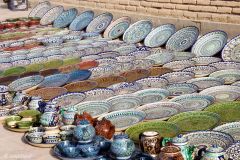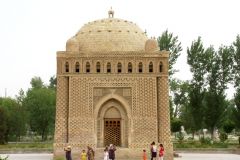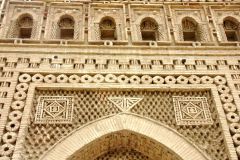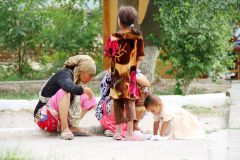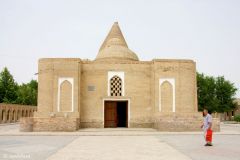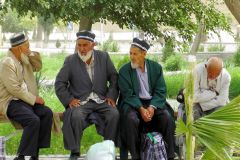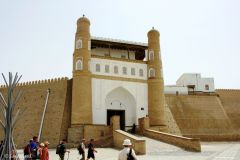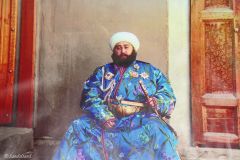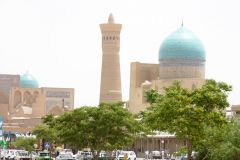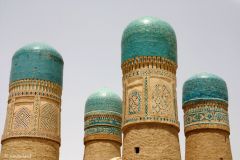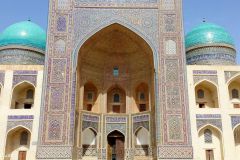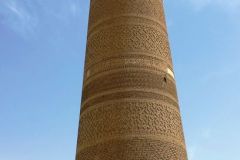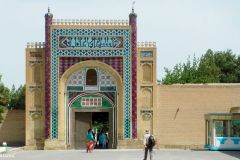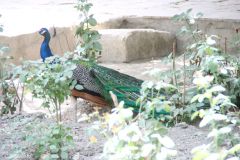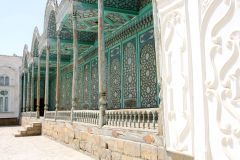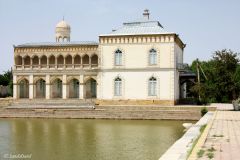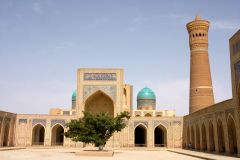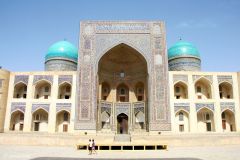The man on the image from 1911 was the last Emir of Bukhara. Join me for a look into days long lost, and read what happened to him and his treasure after he was forced to leave his fortress.
This is part of a series of articles from a journey to the Central Asian republics of Uzbekistan and Kyrgyzstan in June 2014.
Introduction
The oases on the Silk Road were prosperous. Bukhara was one of them, a fortified city, rich on the lucrative trade routes between China and Europe. Here the Emir’s word was the law, his castle was his home, and his concubines were aplenty.
This story from my visit to Bukhara will start with three attractions closely related to the Emirs; the summer palace, the fortress and the minaret. Then we will have a look at other places worth visiting here before we return to the secret of the Emir and his camels.
The Emir’s Summer Palace
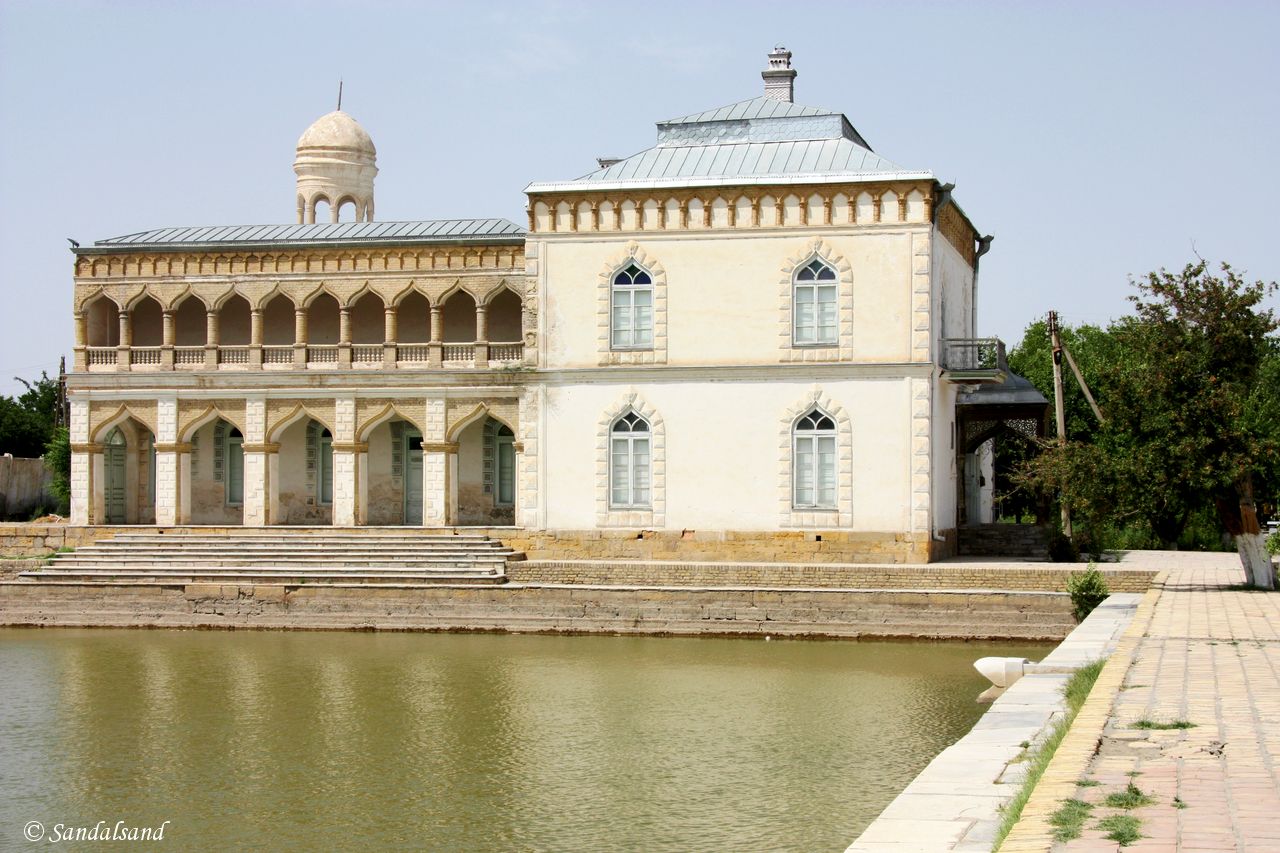
Emir’s Summer Palace
Imagine a nice, bright day in the summer heat. You’re sitting in the shade to the left in this picture. Imagine a basket of apples next to your comfortable chair. Now, take an apple out of the basket and throw it into the pool.
This is what happens: A number of beautiful girls are already in the pool, others jump into it at the sight of the apple.
They all crave for that particular apple, they all rush for it – but only one of the girls gets it. Holding it up, she looks up on the balcony at the man sitting there. The Emir of Bukhara.
She is the winner, and her reward is a night with him.
Can you imagine?
Perhaps not. This actually happened, according to my guide, but one may wonder if the concubines really tried to get hold of that apple or if they only pretended to.
The summer palace in Bukhara is a very nice place to walk around in. Much of it looks like a park, and must have been a park as well one hundred and more years ago. There are several buildings on the premises, many of which contain furniture and more of a Western, or at least Russian, origin. By the end of the 18th century, Central Asia had come under the domination of the Russian Czars, and the young Said Mir Mohammed Alim Khan was sent by his father to St Petersburg to learn how to rule and wage war.
He must have been inspired, because there are a number of furniture, artwork and other artifacts imported from, or inspired by, Russia and the West in the Emir’s Summer Palace.
The Ark
This impressive fortress is dominated by huge walls, high and thick. The entrance is equally impressive, yet narrow. Inside the gate there is a long corridor containing a number of prison cells, visible to all who entered the citadel – a warning of what may be the consequence if you committed anything that might offend the Emir.
There is no town inside the fortress, it was built for the Emir and used by him, his harem and his court. Still, the citizens of the city would take refuge here in times of trouble. The fortress is 1,500 years old, although the structure we today may visit is younger. The invading Red Army bombed it in 1920, and so did Genghis Khan centuries earlier. Today it has been restored to its former glory and is in essence one large museum.
Talking of the Khan: What is the difference between an Emir and a Khan? According to our guide, a ruler in Central Asia who could prove his blood-line back to the great Genghis could call himself “Khan”, the rest used the title of “Emir”. (I am not sure this is actually the case, because the last Emir of Bukhara, had Khan in his name.) By the way, the Bukhara Emirate succeeded the Bukhara Khanate in the late 18th century, in a change of dynasties.
Po-i-Kalan complex
This complex, sometimes written Po-i-Kalyan or Poi-Kalyan, have been in place since the 8th century although the buildings we now see are from the 16th century. Facing a large square we have to our left the large edifice pictured above, a madrasah or religious school. It reminds us of other madrasahs in Central Asia, like the Registan in Samarkand, the portal is the main feature – the rest is modest.
Straight ahead, across the square we face this minaret.
More than 45 metres tall, it is the most awe-inspiring minaret in Central Asia. Made of brick it is covered by symmetrical symbols all the way up. Its nick-name, the Tower of Death, stems from the fact that criminals were thrown off the top.
It was designed to stimulate hope among the followers of Islam, and also to signal the strength and power of the Emir. The rulers of Bukhara became the envy of their competitors, or enemies, in the other cities along the Silk Road. The Khan of Khiva set about building an even larger minaret. Read what happened to that effort in the next chapter of my series from Central Asia.
The other building facing the square is a mosque. It was built with a large interior courtyard like many grand mosques throughout the world.
The power, and economic resources, of the Emir is most of all manifested in the structures of this complex, as well as in the Ark and the Summer Palace. Let us now turn to other attractions worth visiting in Bukhara. We will start with two mausoleums.
Ismail Samani Mausoleum
This is a splendid place. The building is not large, evidenced by the image above, nor does it contain any really significant person. (Ismail Samani may have me excused. He was indeed an emir in a Persian dynasty ruling Central Asia in the 9th and 10th centuries.)
The significance of the mausoleum stems from the fact that there are no older cases of Islamic architecture in Central Asia. In addition the building marks a new era in the development of Central Asian architecture. The old brick construction technique was elevated to a higher level and the details even include features dating back to pre-Islamic culture. In addition there are symbols of both Islam, Christianity and Buddhism.
Chashma-Ayub Mausoleum
This mausoleum is located next to the other and means “Job’s Well”. Which Job? The Biblical of course.
According to the legend, the famous character visited this place at a time of drought, hit the ground with his staff and discovered water. These days, locals enter the building with empty plastic bottles and fill them with holy and healing water. The building was built during the days of Timur the Great (15th century).
Bolo-Hauz Mosque
Situated close to the Ark, this was the Emir’s own mosque, built in the early 18th century with a pond in front. The pond was called the Children’s Pool, or Bolo Hauz in local language, giving name to the entire ensemble of structures here.
The most striking feature of the mosque is its front with the huge wooden pillars holding a gallery with lovely paintings in the ceiling.
Char Minar
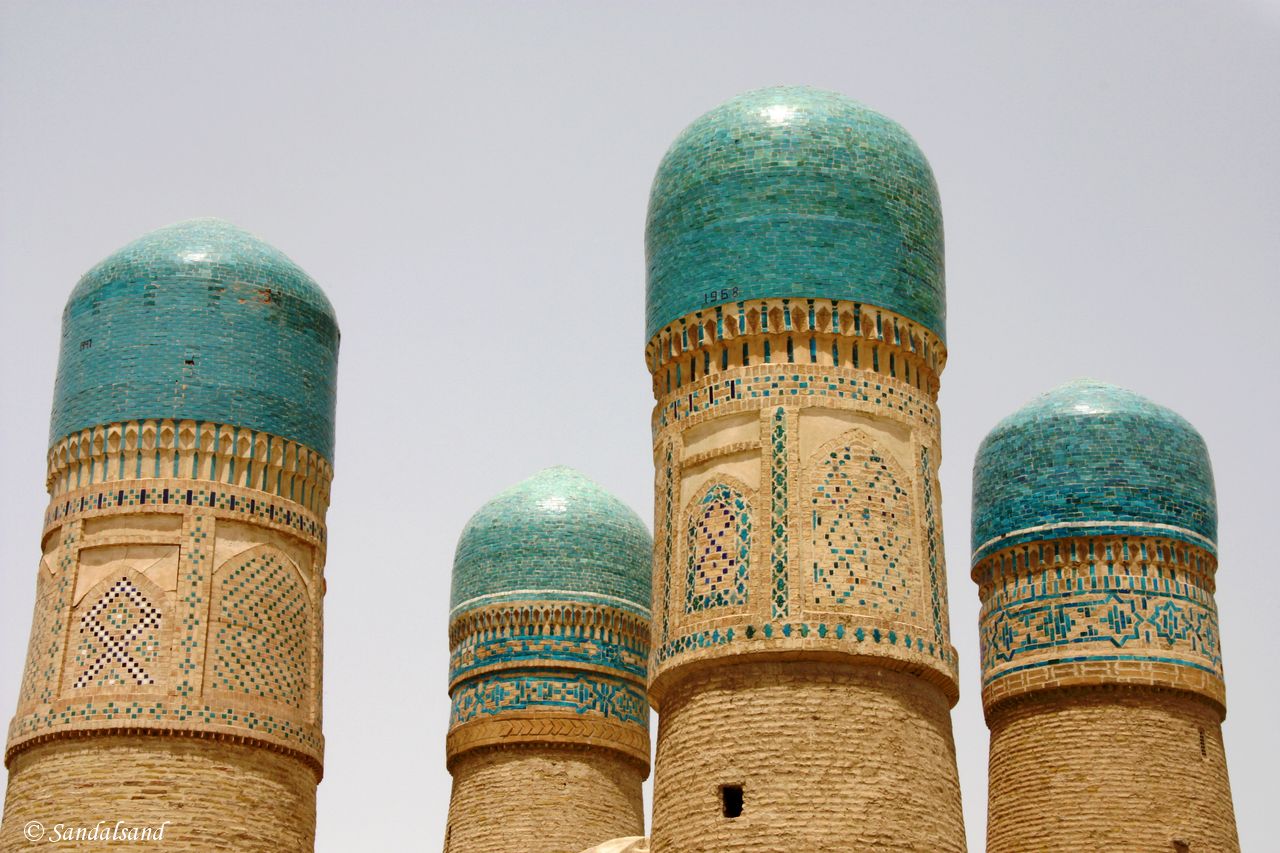
Multiple minarets at the Char Minar
The four minarets or towers of this small mosque stand closely together and make us curious. It is located somewhere inside a maze of side streets and is a wonderful place to visit. The mosque itself is not that much to brag about, but do take notice of the Christian fishes and Buddhist prayer wheels. It is not ancient, only from 1807, kind of Indian style.
Trade dome Tagi Zargaron
Colourful and touristy at night, but still with an aura of authenticity, on should not miss the domes of the ancient (16th century) bazaar on a visit to Bukhara.
There are certainly more ancient buildings to discover in Bukhara. Even though only 8 buildings survived Genghis Khan’s raid, they constructed plenty more later. Most of the sights presented above have gone through extensive restoration, presumably to what they looked like some time in history. At the time of my visit the back side of the Ark had not been fixed yet.
For shopping, one could try the carpet shop near the Po-I-Kalan complex. For nightlife, seek out the area around the large pond Lyab-i-Hauz in the centre. Locals of all ages come here to walk and talk. This is the heart of Bukhara.
The lost camels
Now, what about those camels? My answer is the perfect example of how legends are created, based on rumours told from one person to another. What is fact and what is fiction? Nobody knows for sure.
In 1920 the Red Army attacked Bukhara once again. They had been sent back a few years earlier and now returned in full force. The last Emir of Bukhara, Alim Khan, packed 96 camels with his belongings and fled in the direction of his colleague in Kabul. There he arrived with only 81 camels. The man in Kabul asked him of the whereabouts of the remaining camels, for he was well informed.
Alim Khan could not give him a proper answer, and the story goes that the 15 camels carrying the most valuable parts of the royal treasury was lost somewhere in the mountains. Or hidden there. In any case they have still not been found, so in case you are somewhere in northern Afghanistan you might want to have a look …
Anyway, that’s what I recall my guide told me – and I might have missed some because I can find no evidence of such a story.
The map
This is part of a series of articles from a journey to the Central Asian republics of Uzbekistan and Kyrgizstan in June 2014.
On the map below Leg 1 goes from Tashkent (A) west to Khiva (E) in Uzbekistan. Then a flight back to Tashkent (A) before Leg 2 to Bishkek (F) in Kyrgyzstan.
Read more
The chapters:
(1) In search of the ancient Silk Road
(2) The monumentalism of Tashkent
(4) Shakhrisabz and the birth of a nation
(5) The Emir of Bukhara and the lost camels
(6) The magnificent oasis of Khiva
(7) The fertile Fergana Valley
(8) Nomadic life on the mountain passes of Kyrgyzstan
(9) Bishkek and the valley of Ala Archa
In addition we visited five sites on the World Heritage List. The following article is my special entry from Bukhara.
WHC List #0602 – Historic Centre of Bukhara
Images from Bukhara

